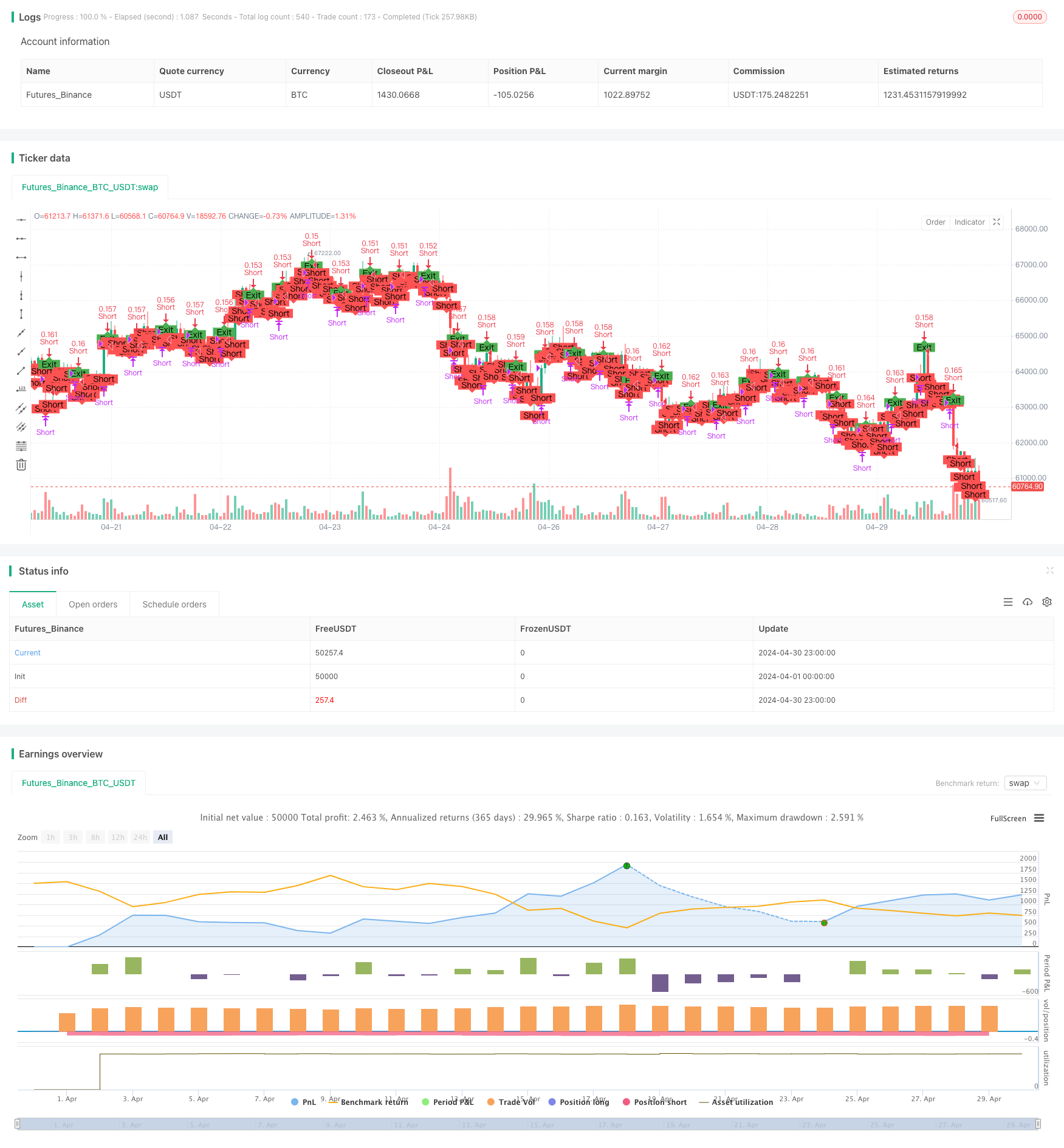
概述
“短线做空高流通货币对策略”旨在利用高流通货币对的短期下跌趋势,在价格预期下跌的情况下进行做空交易,以获取利润。该策略根据特定条件进入空头头寸,并采用动态头寸规模和风险管理措施来控制风险和锁定利润。
该策略的主要思路如下:
- 选择高流通量的货币对作为交易标的。
- 根据价格下跌百分比条件进入空头头寸。
- 动态计算头寸规模,根据账户权益的一定比例控制风险。
- 设置止损和止盈条件,限制潜在损失并锁定利润。
- 根据交易持续时间或价格变动条件退出交易。
策略原理
该策略利用了高流通货币对在短期内的下跌趋势。当价格满足特定条件时,策略会进入空头头寸。具体原理如下:
- 确保当前没有未平仓交易,以保证每次只有一个活跃交易。
- 设置空头交易的持续时间,默认为7天。
- 当价格从进场价格下跌达到预定百分比(默认为30%)时,进入空头头寸。
- 根据账户权益的预定风险百分比动态计算头寸规模,控制每笔交易的资金分配和总体风险。
- 设置止损和止盈条件,当价格向不利方向移动时,策略会退出交易以最小化损失;当价格向有利方向移动时,策略会退出交易以锁定利润。
- 根据交易持续时间或价格变动条件退出交易。
策略优势
- 短期交易:该策略专注于捕捉高流通货币对的短期下跌趋势,交易周期相对较短,有助于快速实现盈利目标。
- 动态头寸规模:根据账户权益的预定风险百分比动态计算头寸规模,有效控制每笔交易的风险敞口,适应不同的市场条件。
- 风险管理:设置止损和止盈条件,在价格向不利方向移动时及时退出交易,最小化潜在损失;在价格向有利方向移动时锁定利润,保护已实现的收益。
- 简单易用:该策略的条件和逻辑相对简单,易于理解和实现,适合不同经验水平的交易者使用。
策略风险
- 市场风险:货币对的价格变动具有不确定性,短期内可能出现突发事件或意外走势,导致策略无法如预期运行。
- 滑点风险:在市场波动剧烈或流动性不足的情况下,实际成交价格可能与预期价格存在差异,影响策略的盈利能力。
- 参数优化风险:该策略的表现依赖于多个参数的选择,如空头持续时间、价格下跌百分比、止损止盈百分比等。不恰当的参数设置可能导致策略表现不佳。
策略优化方向
- 引入更多技术指标:在进场和出场条件中引入其他技术指标,如移动平均线、相对强弱指数(RSI)等,以提高入场信号的可靠性和准确性。
- 优化参数选择:对关键参数进行优化和敏感性分析,如空头持续时间、价格下跌百分比、止损止盈百分比等,找到最佳的参数组合,提高策略的盈利能力和稳定性。
- 加入市场情绪分析:结合市场情绪指标,如恐慌指数(VIX)、交易量等,对市场情绪进行判断,在市场极度悲观或交易量大幅缩减时避免进场,提高策略的适应性。
- 多货币对组合:将该策略应用于多个高流通货币对,构建多元化的投资组合,分散单一货币对的风险,提高整体收益的稳定性。
总结
“短线做空高流通货币对策略”通过捕捉高流通货币对的短期下跌趋势,在特定条件下进行空头交易,并采用动态头寸规模和风险管理措施,以获取利润并控制风险。该策略的优势在于短期交易、动态头寸规模和简单易用,但同时也面临市场风险、滑点风险和参数优化风险。为进一步优化策略,可以考虑引入更多技术指标、优化参数选择、加入市场情绪分析以及应用于多个货币对。通过不断优化和改进,该策略有望在货币市场中实现稳定的盈利。
策略源码
/*backtest
start: 2024-04-01 00:00:00
end: 2024-04-30 23:59:59
period: 1h
basePeriod: 15m
exchanges: [{"eid":"Futures_Binance","currency":"BTC_USDT"}]
*/
//@version=5
strategy("Short High-Grossing Forex Pair", overlay=true)
// Parameters
shortDuration = input.int(7, title="Short Duration (days)")
priceDropPercentage = input.float(30, title="Price Drop Percentage", minval=0, maxval=100)
riskPerTrade = input.float(1, title="Risk per Trade (%)", minval=0.1, maxval=100) / 100 // Risk per trade as a percentage of equity
stopLossPercent = input.float(5, title="Stop Loss Percentage", minval=0) // Stop Loss Percentage
takeProfitPercent = input.float(30, title="Take Profit Percentage", minval=0) // Take Profit Percentage
// Initialize variables
var int shortEnd = na
var float entryPrice = na
// Calculate dynamic position size
equity = strategy.equity
riskAmount = equity * riskPerTrade
pipValue = syminfo.pointvalue
stopLossPips = close * (stopLossPercent / 100)
positionSize = riskAmount / (stopLossPips * pipValue)
// Entry condition: Enter short position at the first bar with calculated position size
if (strategy.opentrades == 0)
strategy.entry("Short", strategy.short, qty=positionSize)
shortEnd := bar_index + shortDuration
entryPrice := close
alert("Entering short position", alert.freq_once_per_bar_close)
// Exit conditions
exitCondition = (bar_index >= shortEnd) or (close <= entryPrice * (1 - priceDropPercentage / 100))
// Stop-loss and take-profit conditions
stopLossCondition = (close >= entryPrice * (1 + stopLossPercent / 100))
takeProfitCondition = (close <= entryPrice * (1 - takeProfitPercent / 100))
// Exit the short position based on the conditions
if (strategy.opentrades > 0 and (exitCondition or stopLossCondition or takeProfitCondition))
strategy.close("Short")
alert("Exiting short position", alert.freq_once_per_bar_close)
// Plot entry and exit points for visualization
plotshape(series=strategy.opentrades > 0, location=location.belowbar, color=color.red, style=shape.labeldown, text="Short")
plotshape(series=strategy.opentrades == 0, location=location.abovebar, color=color.green, style=shape.labelup, text="Exit")
// Add alert conditions
alertcondition(strategy.opentrades > 0, title="Short Entry Alert", message="Entering short position")
alertcondition(strategy.opentrades == 0, title="Short Exit Alert", message="Exiting short position")
相关推荐